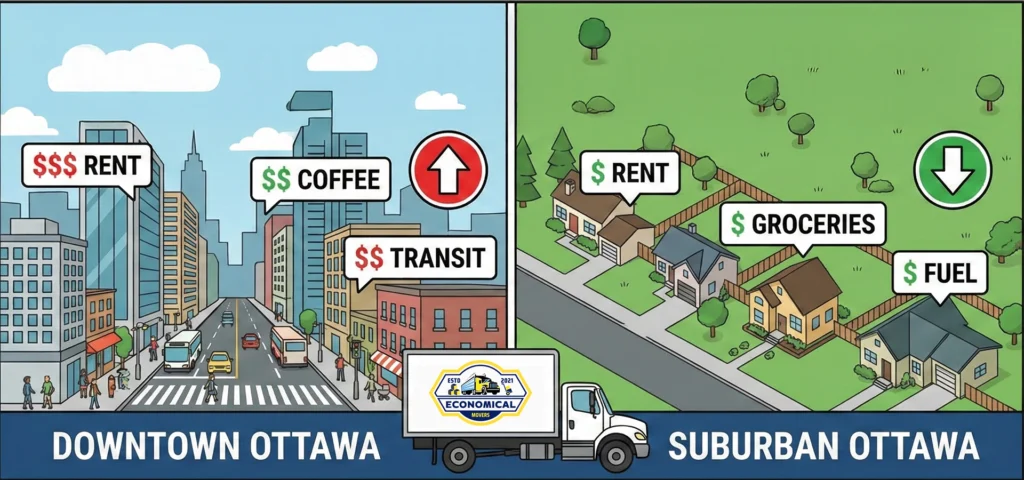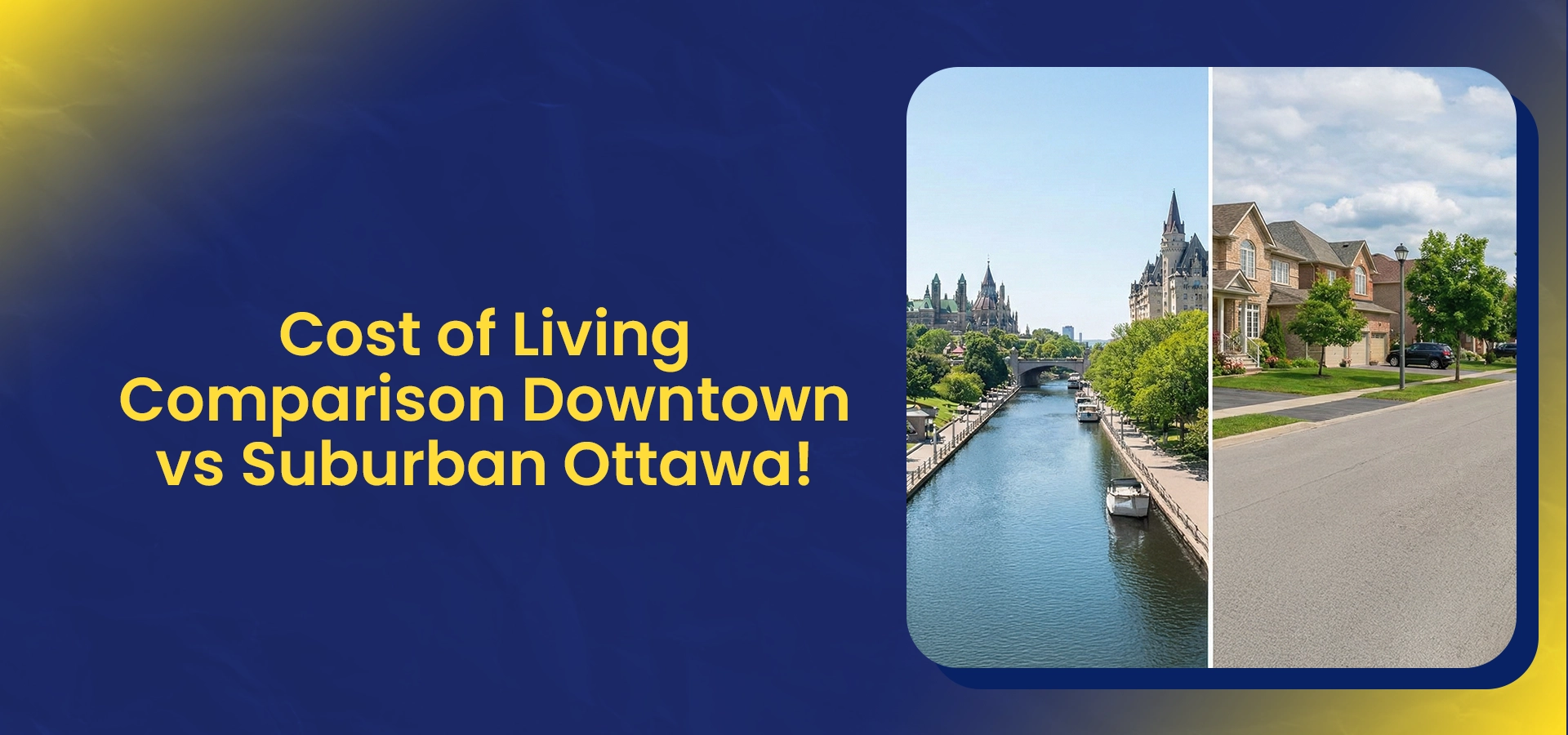Compare the Cost of Living Ottawa residents face in downtown vs suburbs. Learn key differences in housing, utilities, and lifestyle to choose right area.
Choosing between downtown Ottawa and the suburbs usually starts with the same set of real-life questions. People want to get a feel for the cost of living in Ottawa, what rent actually looks like in different neighbourhoods, how long the daily commute might be, and what kind of home they can realistically afford. These are the things people bring up in almost every conversation we’ve had while helping families and individuals move around the city.
Over the years, we’ve seen how different each part of Ottawa can feel once you compare prices, space, and lifestyle side by side. So in the next sections, we’re breaking everything down in a clear, practical way, based not just on general data, but on what we’ve seen firsthand since 2021. Every neighbourhood has its own rhythm and advantages, and this guide is here to help you figure out which one fits your day-to-day life and long-term plans a little better.
Cost of Living Ottawa Overview: Downtown Vs Suburbs
Living costs vary widely depending on location, lifestyle, and household size. This is why many people compare downtown areas with suburban communities when searching for affordable places to live in Ottawa. Downtown tends to be pricier, but it comes with convenience and immediate access to city amenities. Suburban areas are generally more affordable, offer larger living spaces, and provide a more relaxed pace, though commuting times are often longer.
| Lifestyle | Downtown | Suburbs |
|---|---|---|
| Single monthly cost | $1,800–$2,200 | $1,400–$1,800 |
| A couple of monthly costs | $2,800–$3,500 | $2,200–$2,900 |
| Family (2 children) | $4,000+ | $3,200+ |
This estimate includes rent or mortgage, groceries, utilities, transportation, and some discretionary spending. While downtown may feel expensive, the convenience and accessibility often justify the price for those who prioritize proximity to work, nightlife, or cultural events.
Housing Costs In Ottawa: Downtown Vs Suburban Neighbourhoods

Average Rent And Condo Prices Downtown
Downtown Ottawa is home to neighbourhoods like ByWard Market, Centretown, and the Glebe. Apartments here are generally smaller but located within walking distance of offices, cafes, theatres, and parks.
- 1-bedroom apartment: $1,700–$2,200 per month
- 2-bedroom apartment: $2,500–$3,200 per month
- Condos: Starting at $500,000 and up
Space is the trade-off. Many downtown apartments are compact, and outdoor space is limited. Residents often rely on city parks, rooftop terraces, or shared amenities to enjoy outdoor time. On the upside, living downtown means you can leave your car at home and walk or cycle to many places, saving on fuel and parking fees.
Housing Costs In The Suburbs
Suburban neighbourhoods such as Kanata, Orleans, and Barrhaven provide more spacious homes at generally lower costs. They are ideal for families or anyone who prefers quieter streets and larger living areas.
- 1-bedroom apartment: $1,200–$1,600 per month
- 2-bedroom apartment: $1,800–$2,400 per month
- Detached home: $500,000–$700,000
Suburban houses often feature yards, garages, and multiple bedrooms. Many neighbourhoods have parks, playgrounds, and community centers, making them attractive to families with children. While commuting may take longer, the trade-off is often a higher quality of life and more space for home activities.
Comparing Downtown and Suburban Housing: Pros and Cons
| Feature | Downtown | Suburbs |
|---|---|---|
| Unit size | Small | Large |
| Price | High | Moderate |
| Commute | Short | Longer |
| Family-friendly | Limited | Excellent |
Ottawa Commuting and Transportation Costs: Downtown vs Suburbs
Downtown residents benefit from short commutes. Walking, cycling, and public transit are convenient options. Transit passes cost around $120–$150 per month, while parking fees in the core can add hundreds of dollars each month. Average commute times within the downtown area are between 10–20 minutes, which can save hours over the week.
In the suburbs, commuting usually requires a car. Travelling from Kanata or Barrhaven to downtown can take 30–50 minutes during peak hours. Gas, maintenance, and occasional parking fees can significantly impact monthly budgets. Many suburban families find the extra travel time worth the larger home and access to schools, parks, and quieter streets.
Grocery And Food Expenses In Ottawa: City Vs Suburbs
Grocery spending is similar across Ottawa, but lifestyle choices affect total costs.
- Downtown: Singles typically spend $80–$120 weekly, while families may spend $250–$400. Dining out is more frequent, with meals costing $15–$25 per person.
- Suburbs: Weekly groceries range from $70–$100 for singles and $220–$350 for families. Dining out tends to be less common and more affordable.
Shopping habits also influence costs. Downtown residents often visit specialty stores or smaller groceries, while suburban families may shop at larger supermarkets or wholesale outlets. Meal planning and cooking at home can reduce overall expenses in both areas.
Utilities and Household Bills In Downtown and Suburban Ottawa
Monthly utility bills vary by home size and dwelling type.
| Utility | Downtown Apartment | Suburban House |
|---|---|---|
| Electricity & heating | $150–$250 | $250–$400 |
| Water | Often included | $50–$100 |
| Internet | $70 | $70 |
| Waste collection | Included | $30–$50 |
Many downtown apartments include some utilities, simplifying budgeting. Suburban homes often require separate payments for electricity, heating, and water, but the larger space can make it worthwhile for families or those wanting more room.
Healthcare Costs and Accessibility In Ottawa
Healthcare access is an essential consideration for many residents.
- Downtown: Hospitals, clinics, and pharmacies are typically within walking distance. This proximity is useful for regular appointments or emergencies.
- Suburbs: While local clinics exist, major hospitals are farther away, and reaching them may require a car.
Most residents rely on public healthcare, but some opt for supplementary insurance to reduce wait times for specialized care, which can cost between $60–$150 per month per person.
Taxes and Local Fees: What You Pay Living Downtown Or In The Suburbs
Property taxes vary depending on the type and location of the home.
- Downtown condos: Taxes for a $600,000 unit are roughly $4,000 annually.
- Suburban homes: Larger houses may have annual taxes of around $5,000, depending on the lot size.
Other costs, such as municipal fees, parking permits, and waste collection, also differ by neighbourhood. These additional expenses are important to include when budgeting for your living situation.
Lifestyle, Entertainment, And Amenities In Downtown Vs Suburbs
Downtown life is vibrant. Residents have easy access to restaurants, bars, theatres, gyms, and cultural events. Social life is dynamic, appealing to young professionals and singles.
Suburban life prioritizes family friendly amenities: parks, recreational centers, community programs, and quieter streets. Nightlife may be limited, but the abundance of outdoor activities, space, and community involvement make the suburbs attractive to families.
Living Expenses In Ottawa Neighborhoods
Here’s a closer look at some popular areas to give a practical sense of lifestyle and costs:

Downtown Ottawa Neighbourhood Costs and Lifestyle Overview:
- ByWard Market: Known for nightlife, boutique shopping, and restaurants. Apartments cost $1,800–$2,200 per month. Walkable streets make commuting easy.
- Centretown: Close to government offices and cultural institutions. Slightly quieter than ByWard Market. Apartments range from $1,700–$2,500 per month.
- The Glebe: Residential yet vibrant, with local shops and cafes. 1-bedroom apartments average $1,900, while 2-bedroom units start at $2,700.
Suburban Ottawa Neighbourhood Costs and Commute Comparison
- Kanata: Family-friendly with schools, parks, and tech hubs. Detached homes range from $550,000–$700,000. Commutes downtown take 30–40 minutes.
- Barrhaven: A Growing community with shopping, schools, and green spaces. Homes cost $500,000–$650,000, with commutes up to 50 minutes during peak hours.
- Orleans: Quiet, family-oriented, with larger homes and community facilities. Commutes to downtown take 35–45 minutes, but housing per square foot is more affordable than downtown.
This snapshot helps potential residents visualize costs, amenities, and lifestyle differences across neighbourhoods.
Downtown Vs Suburban Ottawa: Full Cost of Living and Lifestyle Comparison
| Aspect | Downtown | Suburbs |
|---|---|---|
| Convenience | Walking access to work and amenities | Car-dependent, longer travel |
| Housing | Smaller, more expensive | Larger, more affordable |
| Lifestyle | Nightlife, restaurants, cultural events | Parks, schools, family-friendly |
| Noise & Crowds | Busy, noisy | Quiet, peaceful |
How To Choose Between Downtown and Suburban Ottawa
When deciding where to live, consider:
- Budget: Can you afford higher downtown rents, or would suburban savings suit you better?
- Commute: Are you comfortable with longer travel times from the suburbs?
- Lifestyle: Do you prefer the energy of city life or the calm of residential areas?
- Family Needs: Schools, parks, and space may be top priorities for families.
Using online resources, neighbourhood reviews, and budgeting tools can help compare options and identify the area that fits your needs.
Final Thoughts
Downtown Ottawa offers convenience, culture, and short commutes, but at the cost of higher rent and limited living space. Suburban neighbourhoods provide more spacious homes, quieter streets, and family-oriented amenities, though commuting and access to downtown entertainment may take longer.
Ultimately, the decision depends on your personal priorities. A detailed monthly budget including housing, transportation, groceries, utilities, and lifestyle expenses will help you make an informed choice. Living in Ottawa can be rewarding, whether you choose the energetic city core or the peaceful suburbs, it’s all about balancing convenience, comfort, and cost.



